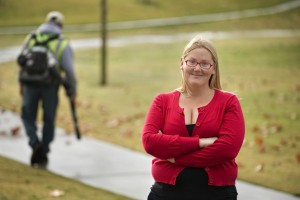Lawn’s carbon footprint
Posted on | January 19, 2010 | 5 Comments

Amy Townsend-Small, UC Irvine, co-author of a new study comparing the carbon storage-versus-emission profile of Southern Californian lawns. Photo: Steve Zylius, UC Irvine
Smoking kills and lawn grooming contributes to global warming, reports the American Geophysical Union.
Actually, the AGU press release doesn’t talk about cigarettes, just grass: “Dispelling the notion that urban ‘green’ spaces [read lawn] help counteract greenhouse gas emissions, new research has found — in Southern California at least — that mowing and other lawn maintenance emit much larger amounts of greenhouse gases than the well-tended grass sequesters.
“Turfgrass lawns remove carbon dioxide from the atmosphere through photosynthesis and store it as organic carbon in soil, making them important “carbon sinks.” However, greenhouse gas emissions from fertilizer production, mowing, leaf blowing and other lawn management practices are four times greater than the amount of carbon stored by ornamental grass in parks,” a new study to be published by the AGU shows. To keep reading, click here. Via Inkstain.
Comments
5 Responses to “Lawn’s carbon footprint”
Leave a Reply



January 19th, 2010 @ 8:05 pm
No big surprise but good to have some hard numbers on this.
January 19th, 2010 @ 8:31 pm
Agreed!
January 30th, 2010 @ 9:50 am
More facts making a strong case against lawns as the default landscaping mode. Changing out lawns is hard to get people to do. Cultural inertia and expectations are heavy. And, to effect a change in a person’s yard, the person must have some functional understanding of plant communities and their needs. I would advise a look back to the early days of agricultural extension, when agents in localities helped landowners adapt to the new waves of scientific knowledge. One approach might be to use dollars saved by water conservation to finance more urban lawn change-out education by the UC system, which could employ students as part-time outreach workers.
January 30th, 2010 @ 9:52 am
I like it.
February 2nd, 2010 @ 5:32 pm
Good study-even if they did leave out the greenhouse gases generated to get the water to SoCal to water the grass. The State Water Project is the largest user of electrical energy in the California- not surprising when the SWP pumps lift water 2000 ft over the Tehachapis. All that energy just to water lawns in LA- seems such a waste.